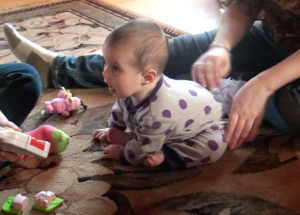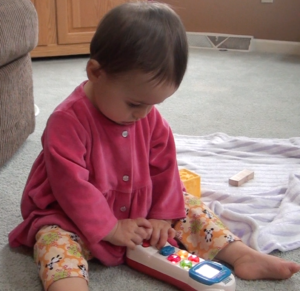
Between the age of six to nine months babies hit a huge milestone that they will continue to do every day, sometimes for several hours a day, for the rest of their life…sitting. Your baby may be already starting to sit unsupported for a few seconds at a time.
 They look so adorable when they sit there unsupported, tiny legs straight out, hands splayed out on the floor infront of them, taking in the world from a whole new vantage point. Notice I said unsupported. That is the sitting I am talking about. Babies can sit much sooner than they can actually sit. Mommies and daddies can plop babies on the floor or in a sitting device where the baby can hold themselves in a static sit, then topple over or slump to the floor as soon as their weight shifts. In my opinion, this static sitting or “placed sitting” is counterproductive. Why do we spend so much time promoting movement and baby exercises when as soon as the baby has a little bit of trunk stability and mobility, we prop them into a sitting position that they could not get into on their own and they have no idea how to safely get out of? Let’s just wait until babies can get into a sitting position on their own!
They look so adorable when they sit there unsupported, tiny legs straight out, hands splayed out on the floor infront of them, taking in the world from a whole new vantage point. Notice I said unsupported. That is the sitting I am talking about. Babies can sit much sooner than they can actually sit. Mommies and daddies can plop babies on the floor or in a sitting device where the baby can hold themselves in a static sit, then topple over or slump to the floor as soon as their weight shifts. In my opinion, this static sitting or “placed sitting” is counterproductive. Why do we spend so much time promoting movement and baby exercises when as soon as the baby has a little bit of trunk stability and mobility, we prop them into a sitting position that they could not get into on their own and they have no idea how to safely get out of? Let’s just wait until babies can get into a sitting position on their own!
When babies are safely able to transition into a sitting position on their own, we call that dynamic sitting or functional sitting. When babies are functional sitters they are able to go from their belly or crawling to sitting on their own and they know enough about how their body works to get out of the sitting position when they are ready. They are able to twist and turn and reach to the left and right while in sitting without toppling over. They can turn and look around, reach out, and pick up a toy and play with it while still in the sitting position, then transition back to crawling or scooting when they are ready to move along.
Babies learn to be functional sitters from repeated attempts to get into this sitting position on their own and lots of practice with supported sitting on parents’ laps. Supported sitting and tummy time help to strengthen trunk muscles to gain that important balance and trunk stability for sitting.

Babies who are placed in a sitting device or propped with pillows in a sitting position are not really learning to sit because they are not getting any practice with the movements necessary to learn balance and control. Functional sitters who learn to get into that position by trial and error have learned and practiced the skills necessary to control their bodies in those transitional movements, making them safer and less prone to injury. Functional sitters also have better body awareness, coordination, and confidence because they know where they are and how they got there, reducing anxiety and increasing their sense of independence.
Please note that this independent transition to sitting resulting in functional sitting doesn’t typically happen  until seven to eight months, whereas placed sitting occurs closer to six months. At six months continue to give your baby lots of movement, mobility, and activity, including tummy time (up to 50% of their awake time) to build a strong core, shoulders, hips, and neck. Allow them tons of time on the floor to explore, use their gross and fine motor skills and develop strength and visual skills. It is also important to remember to sit your baby upright in your lap for balance practice and cuddles, but try to avoid placed sitting. Let them MOVE!
until seven to eight months, whereas placed sitting occurs closer to six months. At six months continue to give your baby lots of movement, mobility, and activity, including tummy time (up to 50% of their awake time) to build a strong core, shoulders, hips, and neck. Allow them tons of time on the floor to explore, use their gross and fine motor skills and develop strength and visual skills. It is also important to remember to sit your baby upright in your lap for balance practice and cuddles, but try to avoid placed sitting. Let them MOVE!
References:
American Academy of Pediatrics https://www.aap.org/en-us/Pages/Default.aspx
World Health Organization http://www.who.int/mediacentre/infographic/new-born/en/
Center for Disease Control https://www.cdc.gov
American Journal of Occupational Therapy https://ajot.aota.org
American Occupational Therapy Association. https://www.aota.org
Healthy Newborn Network http://www.healthynewbornnetwork.org/hnn-content/uploads/Every_Newborn_Action_Plan-ENGLISH_updated_July2014.pdf
Zero to Three https://www.zerotothree.org
Aamodt, S. & Wang, S. (2011). Welcome to Your Child’s Brain: How the Mind Grows from Conception to College. Bloomsbury, NY.

